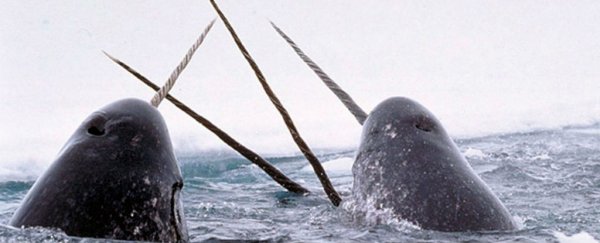It doesn't get much better than a narwhal. These bizarre creatures are a species of toothed whale, and the males have evolved an extra long left canine tooth that can grow up to 2.7 metres (9 feet) long, bursting through the upper lip and protruding from the head like the horn of a unicorn.
The mystery of why these 'horns' exist has led scientists to a number of possible functions - they appear to signal testicle size to the females, and they're sometimes used in battles like a fencing foil. That tooth can also be used for navigation - and now scientists have discovered that it gives narwhals the most directional sonar of any species on Earth.
A team led by Kristin Laidre, an ecologist at the University of Washington, decided to investigate the echolocation skills of narwhals by placing waterproof sound-recorders called hydrophones at 11 pack ice sites in Baffin Bay, West Greenland.
Echolocation - or 'bio sonar' - is used by many species of marine mammals, including dolphins and whales, to help them navigate in the murky depths of the ocean without straining their eyes.
This is especially important for narwhals (Monodon monoceros), because unlike most whale species, they spend their entire lives in the extreme Arctic waters, living under vast blocks of ice that barely let any sunlight in to illuminate the water.
"You don't see open water for miles and miles and suddenly there's a small crack, and you'll see narwhals in it," Laidre told Joanna Klein at The New York Times. "I've always wondered how do these animals navigate under that, and how do they find these small openings to breathe?"
Instead of perceiving obstacles like we do with our eyes, narwhals produce clicking sounds, and listen to the echoes to form a reconstruction of their surroundings based on how those sound waves bounce off nearby prey or rock formations.
These clicks, which can be produced at a rate of up to 1,000 clicks per second, cannot be perceived by the human ear. Their echoes are then detected by fleshy pads in the narwhals' lower jaws.
Laidre and her team placed hydrophones at depths between 3 and 18 metres to figure out when and where the narwhal populations would make their clicking sounds, and how they responded to the echoes.
They found that rather than using their sonar skills like a floodlight to take in a vast array of objects all at once, narwhal clicks were extremely directional, allowing them to home in on things like a flashlight.
As they effectively switch this sonar flashlight on and off, narwhals are able to piece together smaller, more detailed snapshots of their environment into what the researchers suggest is the highest resolution reconstruction of any animal on Earth - with the possible exception of the beluga whale.
Once this broad picture has been painted via echolocation, the narwhals can fill in the details, such as the movement of prey or the scent of a mate, using that long, porous tooth.
As researchers found in 2014, the tooth has foregone the protection of hard, external enamel to make it sensitive to even the tiniest of stimuli.
"Sea water enters the horn through cementum channels, which are also present in human teeth," James Maynard reports for Tech Times.
"The liquid then travels through a network of tubules to the centre of the tooth, heading base of the tusk. There, the water excites nerve endings in the pulp of the tooth, sending signals to the brain of the animal."
The more we find out about this elusive and incredibly unique animal, the more clear it becomes that any disturbances, such as human-caused sound pollution, would be devastating to their ability to survive in an already warming environment.
Laidre and her team now have to figure out how to unlock more of the secrets of the narwhal to help conserve the species, without threatening one of their biggest assets - mystery.
"Narwhals are living a secretive life in the Arctic, but this study has unveiled one of the secrets from the deep waters in the Arctic," ecologist Mads Peter Heide-Jørgensen, from Greenland Institute of Natural Resources, who was not involved in the study, told The Times.
The research has been published in PLOS One.
